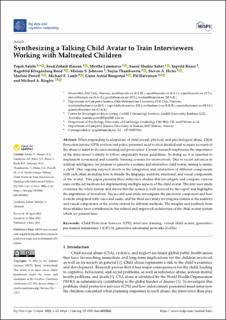| dc.contributor.author | Salehi, Pegah | |
| dc.contributor.author | Hassan, Syed Zohaib | |
| dc.contributor.author | Lammerse, Myrthe | |
| dc.contributor.author | Shafiee Sabet, Saeed | |
| dc.contributor.author | Riiser, Ingvild | |
| dc.contributor.author | Røed, Ragnhild Klingenberg | |
| dc.contributor.author | Sinkerud Johnson, Miriam | |
| dc.contributor.author | Hicks, Steven | |
| dc.contributor.author | Thambawita, Vajira | |
| dc.contributor.author | Powell, Martine | |
| dc.contributor.author | Lamb, Michael E. | |
| dc.contributor.author | Baugerud, Gunn Astrid | |
| dc.contributor.author | Halvorsen, Pål | |
| dc.contributor.author | Riegler, Michael | |
| dc.date.accessioned | 2022-10-05T08:40:11Z | |
| dc.date.available | 2022-10-05T08:40:11Z | |
| dc.date.created | 2022-06-07T10:49:26Z | |
| dc.date.issued | 2022-06-01 | |
| dc.identifier.issn | 2504-2289 | |
| dc.identifier.uri | https://hdl.handle.net/11250/3023920 | |
| dc.description.abstract | When responding to allegations of child sexual, physical, and psychological abuse, Child Protection Service (CPS) workers and police personnel need to elicit detailed and accurate accounts of the abuse to assist in decision-making and prosecution. Current research emphasizes the importance of the interviewer’s ability to follow empirically based guidelines. In doing so, it is essential to implement economical and scientific training courses for interviewers. Due to recent advances in artificial intelligence, we propose to generate a realistic and interactive child avatar, aiming to mimic a child. Our ongoing research involves the integration and interaction of different components with each other, including how to handle the language, auditory, emotional, and visual components of the avatar. This paper presents three subjective studies that investigate and compare various state-of-the-art methods for implementing multiple aspects of the child avatar. The first user study evaluates the whole system and shows that the system is well received by the expert and highlights the importance of its realism. The second user study investigates the emotional component and how it can be integrated with video and audio, and the third user study investigates realism in the auditory and visual components of the avatar created by different methods. The insights and feedback from these studies have contributed to the refined and improved architecture of the child avatar system which we present here. | en_US |
| dc.description.sponsorship | This research is sponsored by the Research Council of Norway, project number #314690 (“Interview training of child-welfare and law-enforcement professionals interviewing maltreated children supported via artificial avatars”). | en_US |
| dc.language.iso | eng | en_US |
| dc.publisher | MDPI | en_US |
| dc.relation.ispartofseries | Big Data and Cognitive Computing;Volume 6 / Issue 2 | |
| dc.rights | Navngivelse 4.0 Internasjonal | * |
| dc.rights.uri | http://creativecommons.org/licenses/by/4.0/deed.no | * |
| dc.subject | Child protection services | en_US |
| dc.subject | Interview training | en_US |
| dc.subject | Virtual child avatars | en_US |
| dc.subject | Generative pre-trained transformer 3 | en_US |
| dc.subject | Generative adversarial networks | en_US |
| dc.title | Synthesizing a Talking Child Avatar to Train Interviewers Working with Maltreated Children | en_US |
| dc.type | Peer reviewed | en_US |
| dc.type | Journal article | en_US |
| dc.description.version | publishedVersion | en_US |
| dc.rights.holder | © 2022 by the authors | en_US |
| dc.source.articlenumber | 62 | en_US |
| cristin.ispublished | true | |
| cristin.fulltext | original | |
| cristin.qualitycode | 1 | |
| dc.identifier.doi | https://doi.org/10.3390/bdcc6020062 | |
| dc.identifier.cristin | 2029785 | |
| dc.source.journal | Big Data and Cognitive Computing | en_US |
| dc.source.volume | 6 | en_US |
| dc.source.issue | 2 | en_US |
| dc.source.pagenumber | 1-22 | en_US |
| dc.relation.project | Norges forskningsråd: 314690 | en_US |

